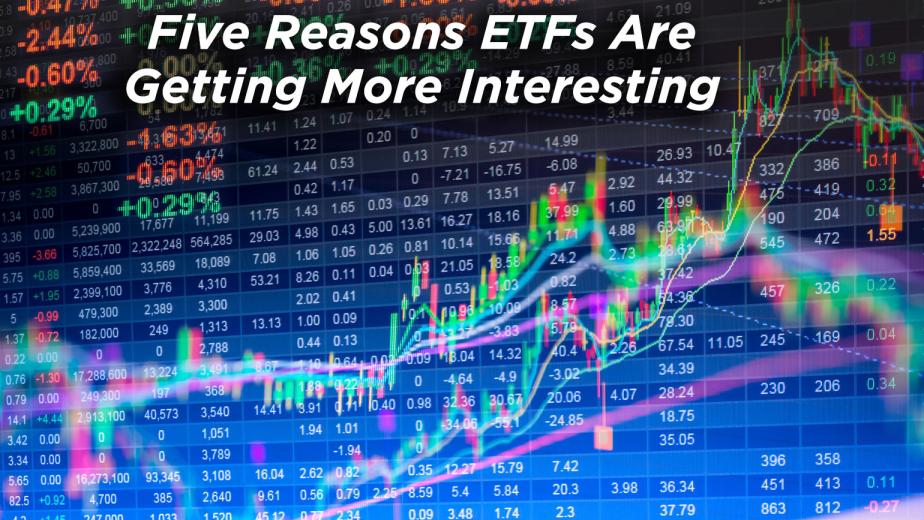1 6
1 6
ADVERTISEMENT
1. ETFs Appeal to Both Strategic and Tactical Allocators
Copyright Thomas Lohnes, Getty Images
Roame notes that some of the advantages of using ETFs are applicable to strategic asset allocators, while other advantages are applicable to market timers and active allocators. Advantages that appeal to strategic allocators include ETFs’ incrementally lower expenses than mutual funds, improved transparency, additional tax efficiency, and a lack of cash drag that funds need to keep on hand. Other advantages include ETFs’ liquidity and continuous pricing, the lack of redemption or short-term trading fees, the ability to place stop loss, market and limit orders, the eligibility for margin purchases and the advantageous short sale rule. These are also factors that are more applicable to the trader.
“So the ETF is a well-supported product with advantages for multiple different market segments, which means, in our minds, will keep its growth rate high,” Roame said.
“So the ETF is a well-supported product with advantages for multiple different market segments, which means, in our minds, will keep its growth rate high,” Roame said.
2. RIAs Are the Biggest Users of ETFs
Tiburon Strategic Advisors
Roame said there are three major ways ETFs are distribution in the U.S.: through advisors, direct to consumers, and through the institutional market.
In 2016, independent advisors, which include RIAs and independent reps, accounted for nearly half (47 percent) of ETF assets under management. Fee account and turnkey asset management programs accounted for 31 percent. Defined contribution plans have 14 percent of ETF assets, and 5 percent goes to other distribution channels.
Fee-based RIAs are more likely to use ETFs, with about 12 percent of client portfolios allocated to the vehicle, compared to 6.5 percent for wirehouse and independent brokers. While that may not seem like a lot, there is a flow of incremental money.
“Advisors with built-in capital gains aren’t going to go selling off mutual funds or individual securities to flip those client assets into ETFs. So this number grows, by and large, from net flows,” Roame said.
In 2016, independent advisors, which include RIAs and independent reps, accounted for nearly half (47 percent) of ETF assets under management. Fee account and turnkey asset management programs accounted for 31 percent. Defined contribution plans have 14 percent of ETF assets, and 5 percent goes to other distribution channels.
Fee-based RIAs are more likely to use ETFs, with about 12 percent of client portfolios allocated to the vehicle, compared to 6.5 percent for wirehouse and independent brokers. While that may not seem like a lot, there is a flow of incremental money.
“Advisors with built-in capital gains aren’t going to go selling off mutual funds or individual securities to flip those client assets into ETFs. So this number grows, by and large, from net flows,” Roame said.
3. Millennials Plan to Buy More ETFs
Tiburon Strategic Advisors
The millennial generation now allocates 36 percent of their portfolios to ETFs, Roame said, compared to 23 percent for all investors. In addition, two-thirds of millennials say they plan to buy more ETFs this year, versus 43 percent of all investors.
“If millennials are the growing population—if they’re the next big investor set—and they’re utilizing ETFs more, hmm, sure seems like ETFs are going to grow to me.”
“If millennials are the growing population—if they’re the next big investor set—and they’re utilizing ETFs more, hmm, sure seems like ETFs are going to grow to me.”
4. ETFs Haven’t (Yet) Cracked the 401(k) Market
Copyright Alex Wong, Getty Images
Roame predicts the ETF market will make a successful push into the 401(k) market. When mutual funds got into 401(k)s, their growth took off. ETFs haven’t yet cracked this market, but as they do, they’ll become even more well-known and more dollars will flow there.
5. Second Tier Players Will Gain Market Share
Tiburon Strategic Advisors
While the ETF industry is currently dominated by three big players—BlackRock, Vanguard and State Street—who have $2 trillion of the $2.4 trillion in total assets, the second tier players are doing quite well, Roame said. Players like Invesco (PowerShares), Deutsche Asset Management, Nomura Asset Management and Charles Schwab already hold tens of billions in ETF assets. And some of these players are quite profitable because they offer niche products with higher fees.
Roame expects there to be a broadening of market share, with these second tier players starting to chip away some minor percentage points from the top players.
Roame expects there to be a broadening of market share, with these second tier players starting to chip away some minor percentage points from the top players.

